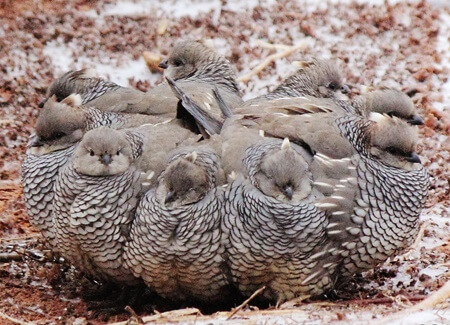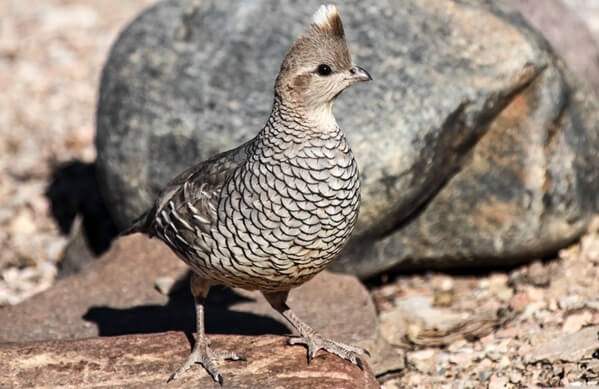 The Scaled Quail is a member of the New World quail family, along with Northern Bobwhite. It's more closely related to California and Gambel's Quail, although it lacks the striking appearance of those species. Instead, Scaled Quail's appearance helps it disappear into the dry grasslands of Mexico and the southwestern United States.
The Scaled Quail is a member of the New World quail family, along with Northern Bobwhite. It's more closely related to California and Gambel's Quail, although it lacks the striking appearance of those species. Instead, Scaled Quail's appearance helps it disappear into the dry grasslands of Mexico and the southwestern United States.
Gray and buff plumage edged with darker feathers gives this bird a distinctly scaly look. Its popular nickname, "cotton-top," refers to the white tuft of feathers on the bird's crest.
Scaled Quail tend to be inconspicuous, but spring brings the males into the open, where they call from an exposed perch with a nasally “pay-cos, pay-cos.” They're becoming harder to see, though, due to population declines. According to the North American Breeding Bird Survey, the Scaled Quail population fell by 57 percent between 1966 and 2014. Habitat loss, especially overgrazing, is the primary driver of these declines.
Scaled Quail are also sensitive to rainfall amounts. Drought years, which may be increasing with climate change, mean fewer birds.
Bird of Arid Lands
Sharing habitat with species such as Varied Bunting and Black-throated Sparrow, Scaled Quail are non-migratory and tend to live within a relatively small range. They are most successful in areas with a high diversity of native plants, such as mesquite and prickly pear, and tend to avoid areas invaded by non-native vegetation.
There are four recognized subspecies of Scaled Quail, three found in the U.S. and one in Mexico. The subspecies found in south Texas is sometimes called the Chestnut-bellied Quail, referring to its dark brown belly feathers.
Quick-running Quail
When Scaled Quail feel threatened, they prefer to run rather than fly. They are fast runners, reaching speeds above 15 miles per hour. Foraging on the ground in groups called coveys, the birds feed on seeds, insects, and plant material, often whistling and calling to stay in contact with one another.

Scaled Quail covey by Deb Whitecotton
Outside of the breeding season, Scaled Quail coveys can be large, averaging around 30 birds. At night they roost together in circles, facing outward to help reduce their vulnerability to predators. The cooler the temperature, the tighter this roosting circle tends to become. Coveys break up in the spring as males and females form breeding pairs.
Ground-nesting Gamebird
Like Greater Sage-Grouse and Greater Prairie-Chicken, Scaled Quail build their nests on the ground, usually under cover of a protective shrub or overhanging rock.
Clutch size averages about 13 but may reach as many as 18 eggs. Although the number of eggs may seem large, it has a purpose: Scaled Quail nests and young fall victim to a wide variety of predators, and only around 30 percent of the chicks survive their first year.
Immediately after hatching, the downy, precocial chicks follow the parents away from the nest site, possibly in an effort to avoid attracting predators. Both parents accompany and care for the brood during its first weeks.
Sign up for ABC's eNews to learn how you can help protect birds
Conserving a Suite of Desert Birds
While Scaled Quail remains widespread, the species' steep population declines indicate the need for conservation action. ABC has teamed with many on-the-ground partners such as Pronatura Noreste to ensure that native grasslands remain available for Scaled Quail and other resident and migratory bird species.
Our work with the Rio Grande Joint Venture (RGJV) aims to restore and improve desert grasslands for this quail and other species of concern, such as Black-capped Vireo and Sagebrush Sparrow. The RGJV contains several BirdScapes, priority landscapes that provide habitat for both migratory and resident birds.
One of these BirdScapes, the Valles Centrales region in the Chihuahuan Desert grasslands of M exico, provides important wintering habitat for Long-billed Curlew and Sprague's Pipit as well as year-round habitat for Scaled Quail and Worthen's Sparrow.Overgrazing by cattle has created problems in the Chihuahuan Desert, but now conservationists see responsible grazing as part of a solution. Learn more.
Donate to support ABC's conservation mission!



















































